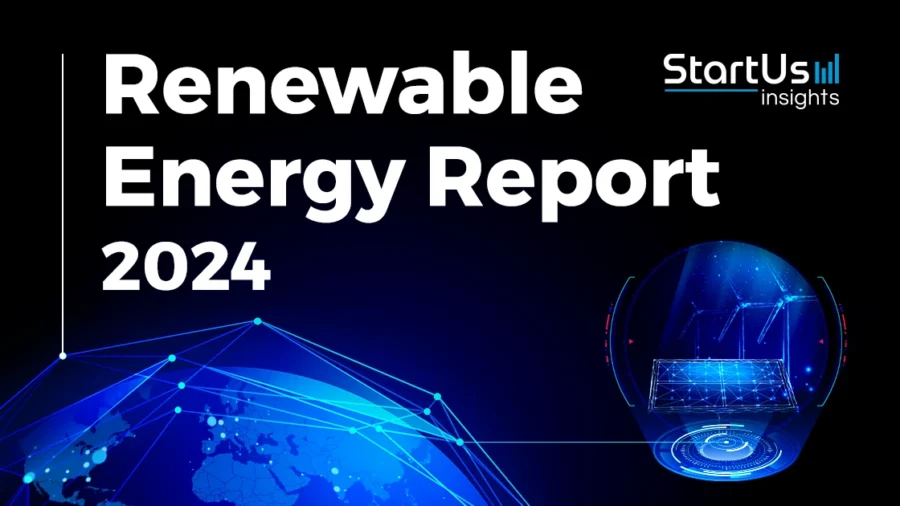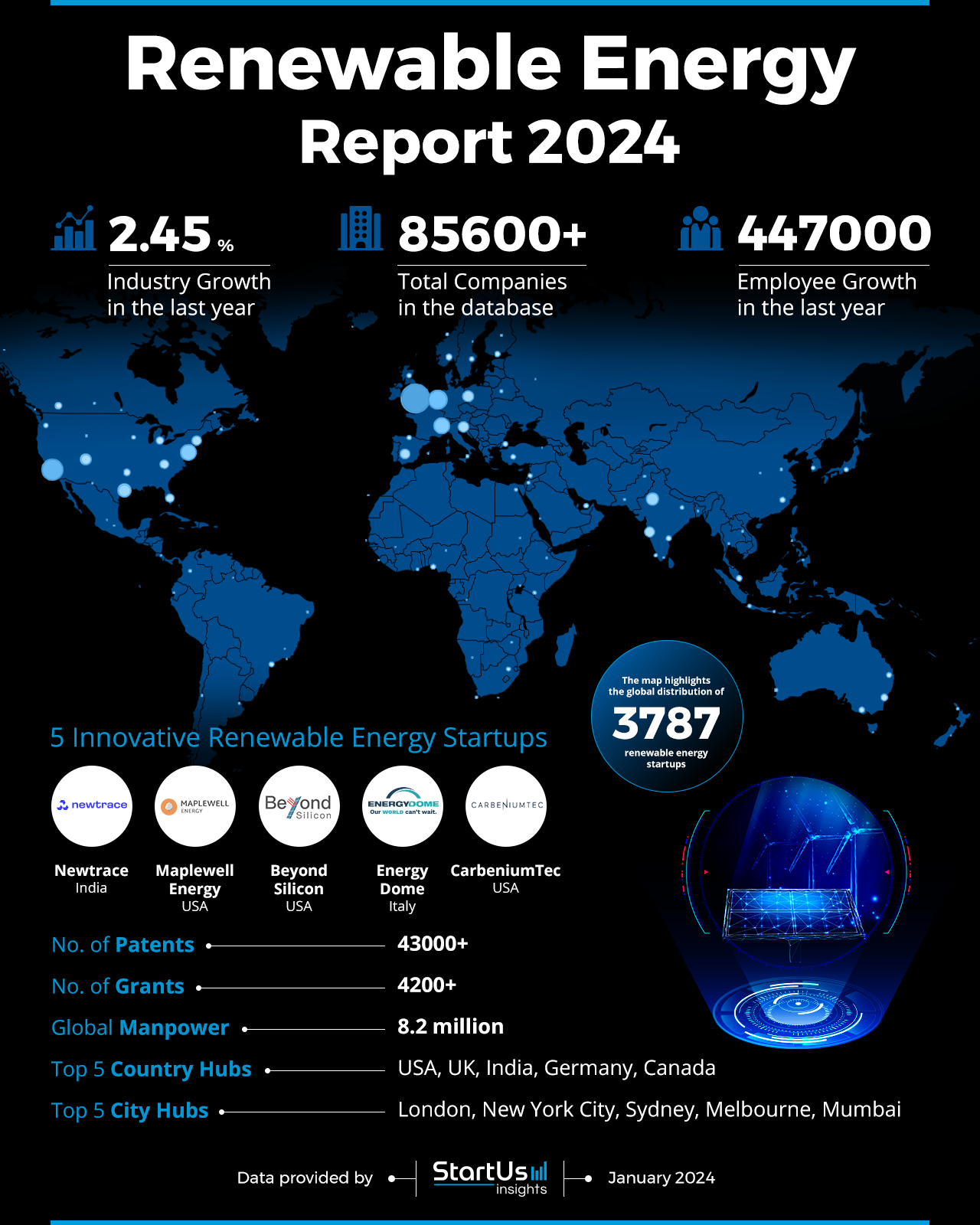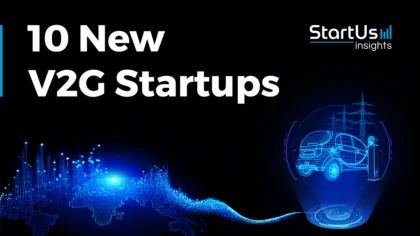In this renewable energy report, we explore the transformative and data-driven strategies playing a crucial role in the industry. As businesses face challenges due to climate change and resource depletion, renewable sources like solar, wind, and hydropower stand out as sustainable alternatives to fossil fuels. Further, advancements in battery technology and materials play a crucial role in global decarbonization efforts.
This report was last updated in July 2024.
This renewable energy industry report serves as a reference for stakeholders within the industry, investors, policymakers, and economic analysts, providing a snapshot of the industry’s health to map its trajectory for innovation and growth in the coming years.
StartUs Insights Renewable Energy Report 2024
- Executive Summary
- Introduction to the Renewable Energy Report 2024
- What data is used in this Renewable Energy Report?
- Snapshot of the Global Renewable Energy Industry
- Funding Landscape in the Renewable Energy Industry
- Who is Investing in Renewables?
- 5 Renewable Energy Startups impacting the Industry
Executive Summary: Renewable Energy Report 2024
This report is created using data obtained from the Big Data and AI-powered StartUs Insights Discovery Platform, covering more than 3.7 million global companies, as well as 20K+ technologies and emerging trends. We also analyzed a sample of 3700+ renewable energy startups developing innovative solutions to present five examples from emerging renewables industry trends.
- Sector Transformation: The renewable energy sector is experiencing dynamic growth, driven by global demand for sustainable energy such as solar, wind, and hydropower.
- Growth Indicators: The industry has seen a 2.45% growth in the last year, with employee growth at 447 000 during the same period, indicating robust expansion and job creation.
- Innovation and Intellectual Property: The sector has filed over 43 000 patents, demonstrating intense R&D efforts and a focus on securing intellectual property.
- Global Reach and Manpower: The industry employs 8.2 million individuals globally, with significant representation in the USA, UK, India, Germany, and Canada.
- Investment Landscape: The average investment value in the sector stands at USD 34 million, with 7300 investors and over 25 000 funding rounds.
- Policy and Global Efforts: Renewables enjoy supportive global policy, with governments offering more incentives and grants to accelerate industry growth.
- Top Investors: Significant financial commitments from top investors like GIC, Warburg Pincus, EnCap Flatrock Midstream, and the US Department of Energy, collectively investing over USD 16 billion.
- Innovative Startups: Highlights include Newtrace (modular electrolyzer systems), Maplewell Energy (DERs management), Beyond Silicon (tandem PV cell), Energy Dome (CO2 Batteries), and CarbeniumTec (organic redox flow battery).
- Future Outlook: Continued growth is expected as technology improves and becomes more cost-effective, with increasing urgency for sustainable energy transition due to climate change impacts.
- Recommendations for Stakeholders: Emphasis on continued investment in innovation, policy support for renewable energy initiatives, and leveraging global efforts for a sustainable energy transition.
Explore the Data-driven Renewable Energy Report for 2024
The Renewable Energy Report 2024 uses data from the Discovery Platform and encapsulates the key metrics that underline the sector’s dynamic growth and innovation. The industry has witnessed a 2.45% growth in the last year, indicative of steady progress in a domain characterized by technological advancements and increasing global demand for sustainable energy solutions.
The report analyzes broad market data as well as more than 3700 startups & scaleups to highlight the sector’s expansion and the vast network of entities dedicated to advancing renewable energy. Employee growth has been particularly robust, with a notable increase of 447 thousand in the past year. This reflects the industry’s role as a significant employer in the global economy and its contribution to job creation in green energy.
The global manpower supporting the industry stands at 8.2 million, emphasizing the vast human capital engaged in renewable energy. The top five country hubs for renewable energy development are the USA, the UK, India, Germany, and Canada. This demonstrates the global spread of renewable energy efforts, with urban centers leading the charge in the implementation of renewable energy solutions. This is visually represented in the heatmap that reveals the global distribution of 3787 renewable energy startups, symbolizing the worldwide shift towards sustainable energy practices.
Finally, highlighting the sector’s innovation, the report considers over 43 000 patents, showcasing the intensive R&D efforts and the emphasis on securing intellectual property rights. Further, the sector has received more than 4200 grants, affirming the support from governmental and institutional bodies for initiatives in sustainable energy.
What data is used to create this renewable energy report?
Based on the data provided by our Discovery Platform, we observe that the renewables industry ranks among the top 5% in the following categories relative to all 20K topics in our database. These categories provide a comprehensive overview of the industry’s key metrics and inform the short-term future direction of the industry.
- News Coverage & Publications: The renewable energy industry has attracted significant media and academic attention, with over 100K publications last year. This reflects its critical role in global discussions and research.
- Funding Rounds: Our database includes data on over 25 000 funding rounds. This shows the sector’s lively investment environment and active pursuit of capital for innovation and growth.
- Manpower: The industry employs over 8.2 million people, with a remarkable increase of over 447 000 new employees last year. This underscores its major role in creating jobs.
- Patents: Renewable energy innovation is growing, as shown by the filing of over 43 000 patents. This indicates a strong focus on technological progress and intellectual property in the sector.
- Grants: The sector has received significant support with over 42 00 grants. This shows recognition and encouragement from both government and private sectors for sustainable energy research and development.
The renewable energy sector is rapidly becoming a cornerstone of the global push towards sustainable development. Read more about its growing workforce, influx of investments, and market activity that paints a picture of a flourishing industry.
A Snapshot of the Global Renewable Energy Industry
Workforce Expansion
The renewable energy sector currently employs 8.2 million people worldwide. This workforce includes engineers, technicians, scientists, and administrators, all focused on developing and implementing renewable energy technologies. In the last year, the sector added 447 000 new jobs, growing at 5.8%. This growth highlights the industry’s vitality and the global shift towards sustainable energy.
Leading in Technology Innovation
The sector continuously drives technological innovation. Renewable technology is leading numerous new scientific research and development projects, with investment opening doors to improve or invent new ways to harness renewable resources. The industry sees a rise in patent filings, collaborative research, and public-private partnerships. These efforts all aim to accelerate the shift to cleaner energy.
Policy and Global Efforts
The global policy environment is also increasingly favoring renewable energy. Governments worldwide are offering incentives to boost industry growth including tax rebates, grants, feed-in tariffs, and renewable portfolio standards. International agreements, like the Paris Agreement, help push the needle on global efforts.
Explore the Funding Landscape of the Renewables Industry
Investment Influx
The sector is experiencing significant financial growth, with average investment in the industry standing at USD 34 million. This figure shows investors’ strong belief in the profitability and future potential of renewable energy. The industry has attracted 7 300 investors, including venture capitalists, government entities, and corporate investors. These investors seek returns and are driven by the social and environmental impacts of their investments.
Market Dynamics
The renewable energy market’s vibrancy shows in over 25 000 closed funding rounds. This high transaction volume indicates a dynamic, innovation-rich market. Funding covers various segments like solar, wind, hydro, and bioenergy, and includes both established companies and startups. This shows the industry’s ability to attract capital and invest it in new technologies and scaling existing solutions.
Economic and Social Impact
The sector significantly impacts the economy; it creates jobs across various regions and communities. The growth in manpower and investments is lowering renewable energy technology costs. This makes them more competitive, which will have deep social effects, especially in developing and poor regions.
Who is Investing in Renewable Energy?
The renewable energy industry is witnessing a transformation fueled by significant financial commitments from top investors. Collectively, these leading entities have poured over USD 16 billion into the sector, a testament to their belief in the long-term viability and importance of sustainable energy.
- GIC: Singapore’s sovereign wealth fund has invested a substantial USD 2.7 billion across 12 companies. This allocation highlights the strategic importance placed on renewable energy as a durable asset class.
- Warburg Pincus: with its USD 2.5 billion investment distributed among 18 companies, it is leveraging its expertise in private equity with diversified investments across multiple companies.
- EnCap Flatrock Midstream: focusing on midstream energy infrastructure, it demonstrates a targeted strategy with USD 2.1 billion invested in 5 companies. These investments underline the importance of expansion and efficiency in renewable energy distribution.
- US Department of Energy: with an investment of USD 2 billion in 70 companies, it emphasizes the US government’s role in fostering innovation and commercialization of renewable energy technologies.
- Canada Pension Plan Investment Board: its stake of USD 2 billion in 6 companies signifies a commitment to responsible investment. It incorporates sustainability into its portfolio for its beneficiaries and the broader environmental agenda.
- European Bank for Reconstruction & Development: it has allocated USD 1.8 billion to 18 companies. Its investments often carry a developmental mandate, aiming to boost economic growth and environmental stewardship.
- Goldman Sachs: with its investment of USD 1.6 billion across 14 companies, it plays a significant role in marshaling capital for renewable energy initiatives. The investment drive shows confidence in the future of emerging renewable energy ventures.
- Generate Capital: with a USD 1.5 billion investment across 8 companies, its unique model focuses on funding and owning sustainable infrastructure that delivers affordable and reliable resource solutions.
Their investments support a range of initiatives, from early-stage technology development to the expansion of established operations. The cumulative impact of these investments is monumental, not only in monetary terms but also in facilitating the advancement of clean energy technologies.
5 Top Examples from 3700+ Innovative Renewable Energy Startups impacting the Industry
The five innovative startups showcased below are picked based on data including the trend they operate within and their relevance, founding year, funding status, and more. Book a demo to find promising startups, emerging trends, or industry data specific to your company’s needs and objectives.
Newtrace builds Modular and Scalable Electrolyzer Systems
Indian startup Newtraces offers modular and scalable electrolyzer systems for green hydrogen production based on an innovative fluid engineering design. Its technology leads to lower capital costs by reducing components and the use of abundant earth metals.
The optimized design also allows for less expensive auxiliary components. Newtraces’ systems are also rapidly scalable for mass production using 3D printing and automated manufacturing. Its electrolyzers and management software enable efficient and cost-effective green hydrogen production to support decarbonization across industries.
Maplewell Energy advances Distributed Energy Resources (DERs) Management
US-based startup Maplewell offers an energy management solution that provides predictive control at the grid edge and in the cloud. JANiiT is its demand-side energy management platform that incorporates AI, predictive control, optimization, and IoT devices to manage flexible loads and DERs. It monitors and tracks energy savings while allowing users to track the performance of their portfolio. Further, its hardware is designed to integrate into existing systems easily.
Beyond Silicon develops Perkovsite-on-Silicon Tandem Cells
US-based startup Beyond Silicon is working on perovskite-on-silicon tandem cells that compete with the efficiency limit of standard silicon solar cells. Its bifacial perovskite and silicon solar modules potentially generate 30% more power than traditional systems. The startup also facilitates its modules as drop-in replacements for silicon PV module manufacturing.
Beyond Silicon’s products allow PV module manufacturers to fabricate and sell high-efficiency modules to increase their profitability while reducing the system cost.
Energy Dome enables Long Duration Energy Storage with CO2 Batteries
Energy Dome is an Italian startup developing a CO2 Battery as an alternative to lithium-ion batteries for long-duration energy storage. It uses carbon dioxide in a closed thermodynamic cycle to store and discharge energy. Energy Dome currently has a MW-scale demonstration plant that is operational.
The CO2 Battery offers cost-effective and durable energy storage using standard, off-the-shelf components, without capacity degradation. Notably, it does not require rare metals or cryogenic temperatures, making it globally scalable and independent of critical supply chains.
CarbeniumTec develops an Organic Redox Flow Battery
CarberniumTec is a US-based startup developing new organic redox flow battery technology that uses a symmetric electrolyte system with a single organic material as both the anolyte and catholyte. This symmetric design improves performance, cycle life, and energy density over previous organic RFBs. The technology offers an inexpensive and environmentally sustainable solution for long-duration energy storage.
CarbeniumTec’s battery uses non-toxic organic electrolytes that are safer and lower cost than corrosive metal electrolytes. Moreover, the symmetric electrolyte results in no cross-contamination between materials. This enables long cycle life and the use of inexpensive porous membranes in the battery cell.
Gain Comprehensive Insights into Renewable Energy Trends, Startups, or Technologies
The renewable energy industry is growing fast in manpower, investment, and market activity. This growth shows its key role in the global shift to sustainable energy. Further, strong backing from investors and governments positions the sector for ongoing upward growth. Emerging renewable energy companies drive innovation and build cleaner, more sustainable solutions for the future. Get in touch to explore all 3700+ startups and scaleups, as well as all industry trends impacting energy companies and cities.








